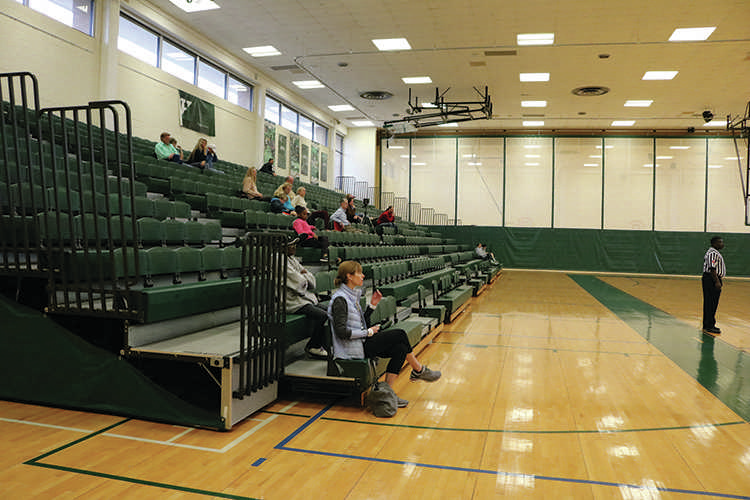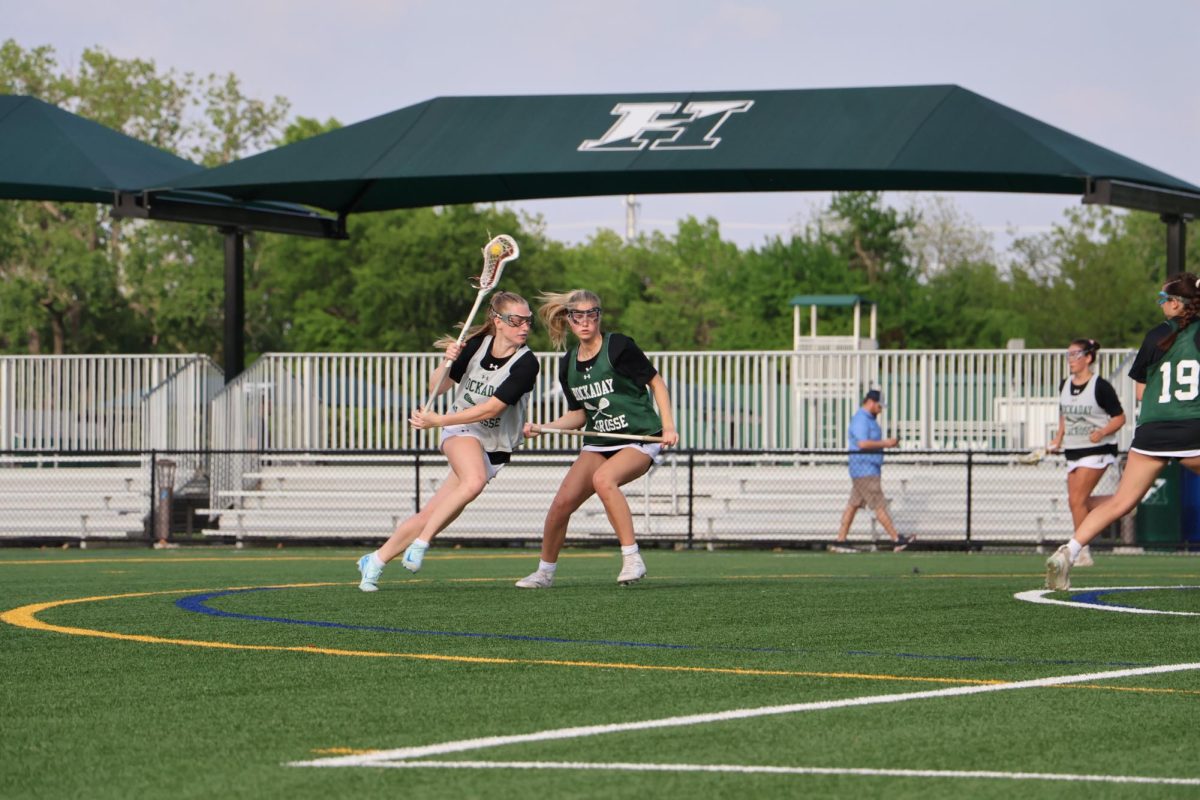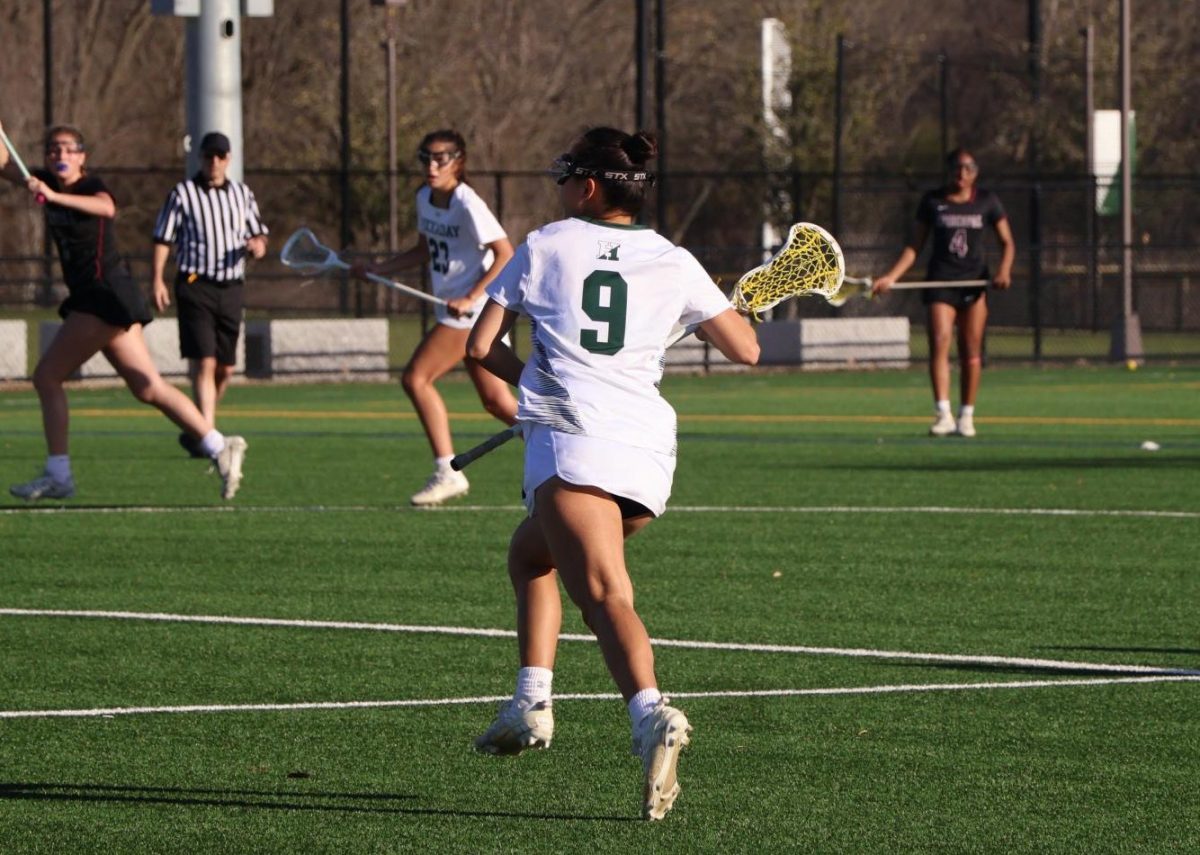PICTURED ABOVE: At an average Hockaday Varsity Basketball home game, the stands consist only of parents and a few coaches. This lack of support is detrimental to the athletes on the court, as they no longer have the home field advantage. This particular game was against Thesa Homeschool.
Google famous athletes. Of the 51 players that pop up on the screen, only four are women. In today’s world, there is a divide between men’s and women’s sports. The lack of support separates the two genders, and the question is: why?
Title IX of the Education Amendments of 1972 claims that no person in the United States should be excluded or denied access to any education or activity on the basis of sex. This includes sports, yet there is noticeable difference in coverage and supporters of certain men’s and women’s sports in today’s world.
The issues are present both at Hockaday and at a professional level. In the Hockaday community, the student athletes constantly struggle with the lack of support for their sports games versus the large amount of support for the St. Mark’s School of Texas sports games.
For example, at a typical Hockaday sports game, only parents and a few coaches can be found in the bare stands. Whereas, at a St. Mark’s sports games, not only do St. Mark’s students support their classmates, Hockaday students flock to the stands to engage in the social event. The crowds are loud, energetic, and St. Mark’s students create merchandise for the students who attend the events. This significant difference in support for Hockaday and St. Mark’s athletics has become a defining factor in the way the sports teams are perceived.
Coach Laboris Bean, Coordinator of Athletic Operations, ran track and field at the University of Oklahoma. Through his experience, he relates this issue back to the culture created in American households.
“It comes back to, not just all about the community, but within the household, for [males] case, guys are looked at to be dominant in sports. Everyone wants to watch the men’s sports and not the women’s sports, unless the women’s sports are next level,” Bean said. “It comes from the home. When you have a son and a daughter, the father wants his son to be successful and his daughter to be great.”
Bean suggests that to change this norm, it must start with the Hockaday students.
“I feel like [change needs to start within] the community, meaning that the girls have to find a way to support themselves and cheer for themselves and make the notoriety of winning next level,” Bean said. “I do not think you have to have guys to make a program on a whole other level in sports.”
When polled in a recent survey, 68.6 percent of the Hockaday student body and faculty said that they attend both Hockaday and St. Mark’s sports events. Only 11.9 percent of students attend only Hockaday sports events.
Steve Kramer, History Department Chair and women’s college volleyball enthusiast, has worked at Hockaday since 1978 and has not witnessed any changes in the environment around Hockaday sports.
“It doesn’t really seem to me that [the sports environment] has changed that much. The girls always have trouble getting people other than their parents and a couple friends to come out,” Kramer said.
The Hockaday parents are the sports teams biggest supporters and usually the only people who come out to the games, except the occasional friends and teachers.
Kramer is an avid supporter of Hockaday volleyball and has noticed the way the sports are being played has changed, but the lack in supporters has always been the same.
“I think how the sports are played has changed, in other words there are more club sports. The kind of athletes that are playing at Hockaday are much better than they used to be,” Kramer said.
Does this lack of support negatively affect Hockaday students?
Varsity basketball player and senior Courtney Katz believes that the atmosphere plays a big role in her sports games.
“I feel like, in basketball especially, it’s a quiet gym, and that’s not the environment it’s supposed to be. It’s supposed to be wild. We’ll play a game and then go to the St. Mark’s game after our game and the stands are packed. The atmosphere definitely makes a difference,” Katz said.
Without the support that Katz mentions, Hockaday lacks the home field advantage. For example, when athletes have home games, the home team is favored due to school support and crowds backing the team. Mentally, this lack of support can have a detrimental effect on athletes; therefore, Hockaday is missing a key aspect in their home games.
Three sport varsity athlete and senior JoJo Gum relates the problem to the difference in school pride between Hockaday students and St. Mark’s students.
“I don’t think girls see athletics as an extension of school pride. Boys want St. Mark’s to win because they want to say ‘Oh, we’re the best at all these sports.’ Whereas at Hockaday, if you’re not on a team, you don’t really take ownership of how the teams are doing,” Gum said.
Katz also believes the social aspect attracts more attention to the St. Mark’s games.
“Part of the problem is that St. Mark’s games are seen as a social event and Hockaday games are just seen as going to be nice to your friends that are on the team, so if our games became more of an event that people would look forward to and they could see other people there as well, it might get people coming,” Katz said.
Both students emphasized the necessity of attending St. Mark’s sports games to become more involved and social, yet the Hockaday sports games don’t seem to have that same effect on students. This might be a result of the lack of boys at the Hockaday sports game or the general atmosphere around the St. Mark’s sports games to bring excitement to the crowd and all the students.
The problem all relates back to the culture Hockaday has created and the lack of emphasis on one of the most forgotten cornerstones: athletics.
Two St. Mark’s students who wish to remain anonymous relate the problem back to society and claim that St. Mark’s works to bring awareness to sports throughout the school week.
“I think that more support for Hockaday sports needs to come from within Hockaday. The Upper School should broadcast the events and provide incentives for people that go, just like St. Mark’s does. St. Mark’s has a lot of activities throughout the week to raise awareness for games, and I don’t know if Hockaday does the same,” the source said.
However, the problem does not only reside in the hands of Hockaday athletics. The gap between women’s and men’s sports constantly makes headlines.
In 2004, Fédération Internationale de Football Association president Sepp Blater said that women should consider wearing more revealing uniforms, such as skimpier shorts, to bring more attention to the game.
In 2015, Sports Illustrated contributer Andy Benoit commented on Twitter that “women’s sports in general are not worth watching.”
In the 2016 Olympic games, after Hungarian swimmer Katinka Hosszu broke the world record in the 400-meter-medley and earned a gold medal, National Broadcasting Company sportscaster Dan Hicks gave all the credit to her coach and husband, Shane Tusup. In other words he discredited her achievement and gave all the praise to men, a prime example of the little recognition professional women’s sports player receive from the media and the sports world.
“And there’s the man responsible,” Hicks said, according to The Washington Post.
Another example of the discrepancy between men’s and women’s sports is depicted in the popular, new spin-off show, “Grown-ish.” In the show, when a revealing poster of a female basketball player was hung above the library, more fans were immediately attracted to the next basketball game. This directly addresses the issue of the morality of fans and the sexism that exists in sports culture.
Overall, Kramer addressed the underlying prejudice against women’s sport with a stereotype he has noticed over the years.
“One of the things you find is some men say ‘I’m not going to watch women’s sports because I know I could beat them even though I didn’t play in college.’ Whether that’s true or not is totally immaterial,” Kramer said. “In other words, they believe that, so they’re not going to watch. They’ll say ‘Well, you’re not at the pinnacle of the sport, and I want to watch the best,’ and there are many women that think that as well. They want to watch the best, and they don’t watch women’s sports.”
Story by Ava Berger, Staff Writer
Photo by Sawyer Bannister









